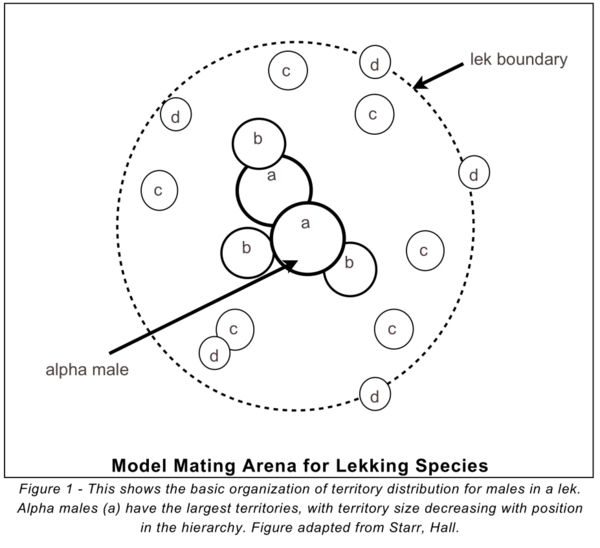| << Chapter < Page | Chapter >> Page > |
Scientists have studied lekking behavior intently, as it appears paradoxical at its very foundations. The epigamic displays often result in significant escalations, leading to the formation of a dominance hierarchy, which serves to establish a rough predictor of mating success in the next generation (Dastagir 1997). Males in the lek defend individual territories, but these territories contain no resources or other benefits to the females (Isvaran 2003). Female choice among the males of the lek is easily observed, but traditional evolutionary approaches and natural selection principles would predict that female choice would eliminate the variation in the traits for which they are selecting, eliminating the great diversity that characterizes a lek. Additionally, the tendency of competing males to establish and defend territories in such a cluster seems paradoxical, as the density of these territories would traditionally escalate the cost of aggression among the males in addition to adding the cost of attracting predators (Isvaran 2003). The growth of female choice alongside the stability of male variation has given this mating behavior the title of the “lek paradox” and has forced scientists to propose various models to explain the behavior (Hamilton 2006). This chapter will address the strengths and shortcomings of the “hotshot,” “hot spot,” and ‘”preference” models, which are the most common explanations for lekking behavior in animal species, as well as evidence for other possible explanations of lekking behavior.
The organization of a lek sets the foundation for the behaviors demonstrated by lekking species. Within the boundary of the lek, each male displaying holds his own display territory, but individual dominance displays vary (Westcott 1994). In an extreme lekking species, multiple males share an area inside which they compete for individual success. On the other extreme, males simply divide the lek into territories and any disruption in mating activities is limited to that between neighbors (Gibson 1987).

The organization of a lek sets the foundation for the behaviors demonstrated by lekking species. Within the boundary of the lek, each male displaying holds his own display territory, but individual dominance displays vary (Westcott 1994). In an extreme lekking species, multiple males share an area inside which they compete for individual success. On the other extreme, males simply divide the lek into territories and any disruption in mating activities is limited to that between neighbors (Gibson 1987).
When females visit the lek, they do so only for the benefit of copulation and choose their mate free from any coercion from the male (Westcott 1994). The allocation of territories and the lack of economic benefit to the female that could have been derived from the male’s land do not seem to have any role in mate selection (Reynolds 1990). The paradox of the lek enters in discussing the preferences of the female. Often on lek, females will show strong preference for and consensus in mate choice, regardless of the fact that the male she is choosing contributes nothing more than genes to her offspring, and the genes that correspond to the traits selected for don’t contribute to the fitness of her offspring to a significant extent (Reynolds 1990). In other instances, the desperate displays of the males have no significant influence on the female’s choice and do not benefit him at all.

Notification Switch
Would you like to follow the 'Mockingbird tales: readings in animal behavior' conversation and receive update notifications?